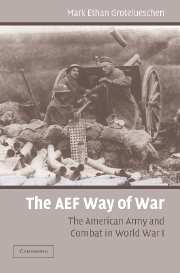Book contents
- Frontmatter
- Contents
- Acknowledgments
- Introduction
- 1 Doctrine, Dogma, and Development in the AEF
- 2 The 1st Division: Training for and Waging Trench Warfare
- 3 The 1st Division: The Search for a “Sufficiently Powerful Fire”
- 4 The 26th “Yankee” Division: Doctrine, Discipline, and Discrimination
- 5 The 26th “Yankee” Division: Doctrine, Demoralization, and Disintegration
- 6 The 2nd Division: Bloody Lessons in “Open Warfare”
- 7 The 2nd Division: The Rise of Set-Piece Battle
- 8 The 77th “Liberty” Division: Training for the Trenches and Fighting on the Vesle
- 9 The 77th “Liberty” Division: Dogma, Delegation, and Discretion
- 10 Conclusions
- References
- Index
2 - The 1st Division: Training for and Waging Trench Warfare
Published online by Cambridge University Press: 29 August 2009
- Frontmatter
- Contents
- Acknowledgments
- Introduction
- 1 Doctrine, Dogma, and Development in the AEF
- 2 The 1st Division: Training for and Waging Trench Warfare
- 3 The 1st Division: The Search for a “Sufficiently Powerful Fire”
- 4 The 26th “Yankee” Division: Doctrine, Discipline, and Discrimination
- 5 The 26th “Yankee” Division: Doctrine, Demoralization, and Disintegration
- 6 The 2nd Division: Bloody Lessons in “Open Warfare”
- 7 The 2nd Division: The Rise of Set-Piece Battle
- 8 The 77th “Liberty” Division: Training for the Trenches and Fighting on the Vesle
- 9 The 77th “Liberty” Division: Dogma, Delegation, and Discretion
- 10 Conclusions
- References
- Index
Summary
The 1st Division was the showcase unit of the AEF. It was the first to arrive, the first to enter and complete training, the first to enter the line, and the first to attack the enemy. As such, Pershing took an extraordinary interest in the division's training and operations. It received the most extensive training of all the AEF divisions. It fought in all three major offensives in which the AEF was a significant or dominant factor: the Aisne-Marne Offensive in July, the St. Mihiel Offensive in September, and the Meuse-Argonne Offensive of September through November. By all accounts, the 1st Division became one of the most successful AEF divisions.
Many senior officers in the 1st Division were handpicked by Pershing and the AEF General Staff. Nevertheless, the division increasingly fought in a style that maximized firepower to secure limited objectives at a minimum cost in human life. Although the unit received more open-warfare training than any other in the AEF, its methods ultimately betrayed a commitment to a style of fighting at odds with the official AEF doctrine that stressed self-reliant infantry, the rifle and bayonet, unlimited objectives, and aggressiveness at all costs. Although the division's relatively lengthy training period allowed it to train for open warfare more than other American units, the unit also spent significant time training under French tutelage and encountering the challenges of living and fighting in the trenches.
- Type
- Chapter
- Information
- The AEF Way of WarThe American Army and Combat in World War I, pp. 59 - 105Publisher: Cambridge University PressPrint publication year: 2006



